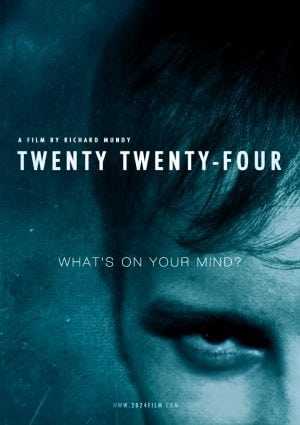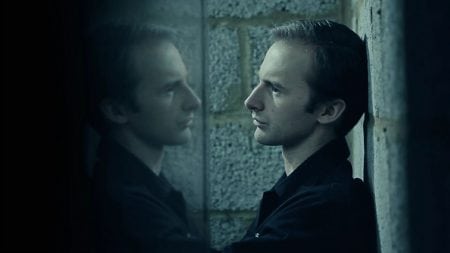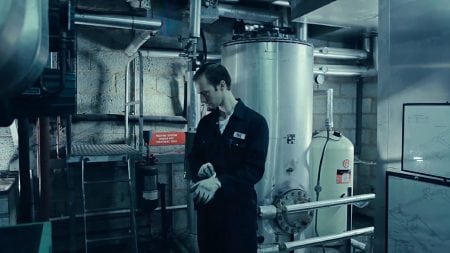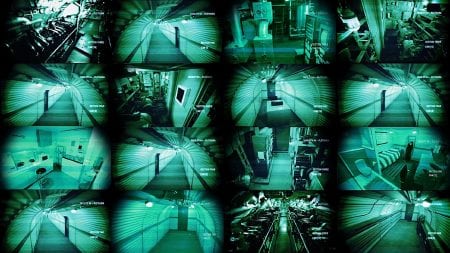Twenty Twenty-Four (2017)
Directed by: Richard Mundy
Written by: Richard Mundy
Starring: Andrew Kinsler, Peter McCrohon

TWENTY TWENTY-FOUR (2017)
Directed by Richard Mundy
If, like many others, you took to social media and said 2016 was the worst year ever then just wait ‘til you learn about 2024. Then, the world’s about to go to war, and more than just the celebrities you used to like as a kid are going to die. In this stunning debut, director/ writer Richard Mundy captures the closing days of humanity as one man, beneath the earth’s surface, helps prep for the apocalypse. Think of it as a very paranoid version of Castaway and set underground.

The lone man is a research scientist named Roy (Kinsler), who’s agreed to look after the bunker, called Plethura, and ready it for the impending nuclear disaster. At which point a number of the world’s most important people will arrive, and he’ll be forced to leave and face the radiation. But ‘til then it’s just him and a computer console, called Arthur, to keep him company. To make matters worse, as the film goes on it becomes increasingly apparent something bad has happened ‘up top’ and he may be permanently isolated. However, worse than being alone is being with someone/ something threatening. And after some inexplicable events start stacking up, including open doors, visions and noises, Roy realises this may be the case. Well, it’s that or he’s losing his mind – not like either’s nice.

What follows is a slow burn horror thriller, which also takes time to ask serious questions between well-judged bouts of silence. Most of these musings come in the form of a very natural dialogue between Roy and his machine. These interactions are a joy to behold, with Kinsler being forever on the edge of flipping but just about managing to hold himself together. Sometimes their exchanges are sad, whilst others are laugh out loud funny. However, mostly they are insightful, with the pair discussing points like if computers can dream, the purpose of living for its own sake and how we create a sense of reality. This strand, in particular, plays with the intriguing premise that everything onscreen is a simulation: a generated nightmare he won’t wake up from. With the only way to test the theory being to go out the door and face the radiation. Sure, these ideas probably showed up in three of the last five sci-fis you saw. Yet by having them confronted so nakedly they’re given a real dramatic gravity here. In addition, it’s interesting how few answers get given.

Despite this sense of hopelessness, as soon as there’s signs of life in there with Roy he knows he doesn’t want to die. Thus the melancholia is countered by an intense fight for survival. During this transition, the long to mid shots from earlier are phased out in favour of claustrophobic close-ups in the very authentic looking bunker. Each pump and cable seem perfectly in place and the clinical aesthetic makes a mockery of the low budget. Pleasingly, the first act, where we watch Roy go about his dull existence, does a commendable job of establishing its geography. Sure, some of the halls recall other films (Alien and 2001, I’m thinking of you). But, as per its themes, Twenty Twenty-Four retains its own identity in the face of cliché. This is in no small part due to an eerie score, which effortlessly goes from minimalism to screeching violins as the second act gives way to full-on terror. Once the tension’s started it never lets off.

You’d assume that, built into the premise, there are only two possible endings. To his credit, Mundy finds a third. Yet it’s one that doesn’t quite do justice to the outstanding build-up, nor its potential. I appreciate not everything needs spelt out, and it isn’t the ambiguity that bothers me. Rather it’s the abruptness that’s extremely jarring. I’d assume this is likely the intention, with the reality of the situation being less important than the character in it – who fully believes it even if audiences haven’t finished deciding. But I’d have wanted something more conclusive. By contrast, the scrolling text at the start went too much the other way, overly explaining a set up conveyed much stronger by gradual reveals. Furthermore, despite appreciating the beautifully captured mundanity of Roy’s every morning, afternoon and evening, I would have liked less slowdown in the second act. True, there’s some form underlies meaning to it. Yet nevertheless, like the marooned scientist, we’ve still got to sit through it. Although, to be fair, for almost all of it I sat through it very happily. You should too: it’s the year’s first excellent horror. Now, filmwise, if 2017 and can be as good as 2016 I’ll be very happy.
Rating: 




For updates on Twenty Twenty-Four you can check the website or follow it on Twitter and Facebook.


Hi
Having watched the film yesterday
I was a taken back with the quality
of Twenty Twenty Four, especially being a low budget film,
The cinemaphography was stunning, the music went hand in hand complementing each scene
with eerie orchestral screems, all this made that little bit special by the showing of this film in what was almost a bunker situation of the Vault venue with the rattle of the overhead trains making it that more atmospheric.
I would imagine this Director will go far and look forward to the next film.
Your reveiw was spot on and I will
now keep my eye on your future work, keep up the good work, very refreshing at last.